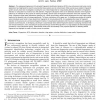PAMI
2012
12 years 2 months ago
2012
Abstract—We propose a robust fitting framework, called Adaptive Kernel-Scale Weighted Hypotheses (AKSWH), to segment multiplestructure data even in the presence of a large number...
PAMI
2012
12 years 2 months ago
2012
—We describe an approach for segmenting a moving image into regions that correspond to surfaces in the scene that are partially surrounded by the medium. It integrates both appea...
PAMI
2012
12 years 2 months ago
2012
—We present a novel framework to generate and rank plausible hypotheses for the spatial extent of objects in images using bottom-up computational processes and mid-level selectio...
PAMI
2012
12 years 2 months ago
2012
—Social media networks contain both content and context-specific information. Most existing methods work with either of the two for the purpose of multimedia mining and retrieva...
PAMI
2012
12 years 2 months ago
2012
—We propose an efficient and robust solution for image set classification. A joint representation of an image set is proposed which includes the image samples of the set and thei...
PAMI
2012
12 years 2 months ago
2012
—The widespread deployment of Automated Fingerprint Identification Systems (AFIS) in law enforcement and border control applications has heightened the need for ensuring that the...
PAMI
2012
12 years 2 months ago
2012
—Model updating is a critical problem in tracking. Inaccurate extraction of the foreground and background information in model adaptation would cause the model to drift and degra...
PAMI
2012
12 years 2 months ago
2012
—We propose a probabilistic formulation of joint silhouette extraction and 3D reconstruction given a series of calibrated 2D images. Instead of segmenting each image separately i...
PAMI
2012
12 years 2 months ago
2012
PAMI
2012
12 years 2 months ago
2012
—We introduce a simple image descriptor referred to as the image signature. We show, within the theoretical framework of sparse signal mixing, that this quantity spatially approx...




